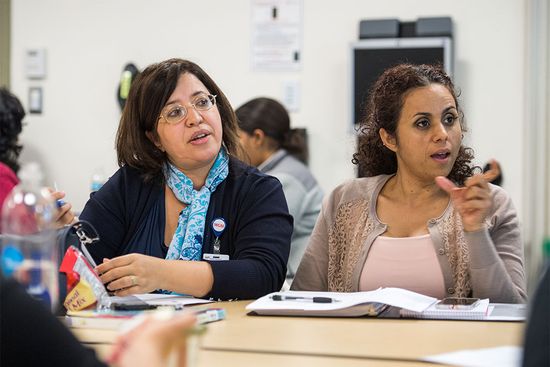Helping Immigrants Understand Their Doctors
SPH student earns Soros Fellowship for nonprofit training medical interpreters

Maria Vertkin started the nonprofit Found in Translation to train low-income women, many of them immigrants, as medical interpreters. The nonprofit offers free classes and has graduated 186 students.
The 20 women sitting around the room at CHA Somerville Hospital could be a caucus of the UN, representing as they do nations ranging from Syria to Nepal. The women, three wearing hijabs, listen attentively as native Turk Sibel Benmayor, standing at the front, leads them through an exercise on nervous system terminology.
“Now we have ‘encephalo,’” Benmayor says, seeking its definition and derivatives. The women, who are studying for national certification tests as interpreters working with medical patients, offer a chorus of answers—“Inside the brain,” “Encephalitis,” “Encephalograph.” The class is half medical school and half language instruction, to the point that Jaya Pandey Shah, originally from Nepal, quips, “We’ll end up becoming doctors.”
Welcome to Found in Translation, a six-year-old Boston nonprofit created by Maria Vertkin (SPH’19) to train and place low-income bilingual women as medical interpreters. The nonprofit, offering free classes paid for by philanthropic donations and income from interpreter services, has graduated 186 students. Many of those graduates are immigrants, as is Russia-born Vertkin.
Found in Translation is a bit of jujitsu, turning immigrants’ seeming weakness—their foreign language—into a marketable skill. It has also made it financially possible for Vertkin to attend the School of Public Health: founding it won her a Paul and Daisy Soros Fellowship, which gives talented immigrants $90,000 toward their graduate education.
She was one of just 30 fellows, most of them Ivy Leaguers, chosen from about 1,800 applicants. (Found in Translation is racking up accolades, having also just won a $25,000 Roslyn S. Jaffe Award for “making the world a better place for women and/or children” in healthcare.)
“Access to a professional medical interpreter is a legally protected civil right,” Vertkin says. “Language is the difference between medicine and veterinary science,” between a healer able to communicate with her patient and one who cannot.
And lack of communication can be deadly.
A Spanish-speaking patient in Maryland died in 2012 from fluid buildup in his abdomen and lungs; no one had talked about his care plan to him in Spanish until 90 minutes before his death. More broadly, a 2012 federal report warns that language barriers jeopardize the health of 9 percent of the US population.

Too often, caregivers, unaware of interpretive services or crunched for time, rely on family members to translate. But relatives, who may be traumatized by their loved one’s illness and unversed in medical terminology, make problematic language aides.
A 2012 study by the American College of Emergency Physicians pegged error rates for professional interpreters at 12 percent, versus 22 percent for ad hoc interpreters.
Even without a health catastrophe, Vertkin says, if patients can’t understand doctors, “we’ve just happily stripped many immigrant patients of their right to informed consent.”
“Participating in group classes has inspired me to learn better,” Shah says. “The ladies in the group motivate me to study, as I look up to them.” That motivation has paid dividends for Shah, who has secured jobs as a per diem interpreter “in many prestigious organizations and hospitals,” she says.
Benmayor, herself a graduate of Found in Translation, took the coursework after she’d accompanied her parents in Turkey to a hospital where they volunteered. “I love medical interpreting, as I feel I am helping people,” she says.
Vertkin’s own passion for the topic was born in part from personal experience. Her university-educated parents (her dad was a chess master) left the crumbling Soviet Union when she was six. They went to Israel, only to experience what she calls prejudice toward immigrants from Israelis. (Her parents took factory and cleaning jobs, she says.)
They moved again, just before she turned 11, to the United States. Whenever the family went to the doctor, she says, “I don’t remember even one time where we got a professional interpreter.” Recently, she’s accompanied her dad “as his advocate so that he would get a professional interpreter.”
As a social worker, Vertkin has worked with immigrant families with experiences similar to her own. Googling for ways they could use their foreign language proficiency, she came across medical interpretation, which, she discovered, is a growth industry that “pays you the equivalent of master’s degree wages—and you don’t need a master’s degree.”
“If anybody shows up in a US healthcare facility…whether they speak Albanian or Zulu, we have to treat them in Albanian or Zulu. If we try to speak to them in English,” she says, “that’s not only unethical and very dangerous, it’s illegal. But it’s happening all around, because we’re talking about a silent population, so it’s very easy to violate their rights.”
Vertkin hopes her SPH studies will add scholarly perspective to her toolkit. “It’s such a multipronged problem,” she says, “so the solution has to be multipronged. It’s going to have to be epidemiology, it’s going to have to be social work, it’s going to have to be workforce development, there has to be a legal and policy side. And these are all things I’m hoping to learn.”
Comments & Discussion
Boston University moderates comments to facilitate an informed, substantive, civil conversation. Abusive, profane, self-promotional, misleading, incoherent or off-topic comments will be rejected. Moderators are staffed during regular business hours (EST) and can only accept comments written in English. Statistics or facts must include a citation or a link to the citation.